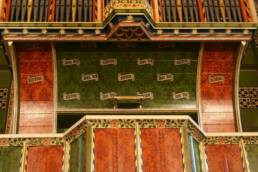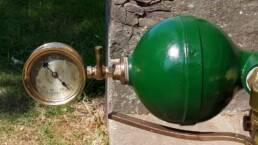Further Information
Organ

The organ was installed by RW Walker & Sons in 1872 and is sited across the west wall of the nave, in a polychrome case designed by Gilbert Scott junior and richly decorated by Charles Eamer Kempe. It replaced an earlier Samuel Green organ installed 86 years earlier in 1786, which still survives and can be seen at Croft Castle in north Herefordshire. Details of its original specification in 1872 and how this has been altered between now and then can be found by clicking on the link below.
Hydraulic Engine


There is some uncertainty about the exact date when organ hydraulic or water engines of this sort were invented but the first working engine was patented by David Joy, the famous steam engineer and inventor of Joy’s Vale gear. This would have been around the mid 1800’s and was apparently in response to his having to pump an organ whilst visiting relatives. His background in steam engine engineering is reflected in the design which remained unaltered in all subsequent engines brought out by other manufacturers. Within a short period other manufacturers came up with their own designs across the world and one of these was the Bailey Patent Water Engine. It is this engine that was installed in this church. W.H. Bailey & Co Ltd. of Salford were advertising themselves as hydraulic engineers by 1879 and presumably the engine was installed around this time.
The above illustration of their horizontal engine shows how similar in design it is with the engine in our church.
As with many installations the engine at Moccas directly replaced the manual operation of the feeders by the original blowing handle. At some point in the engine’s history it was altered, possibly due to the wear of the original timber lever and linkages. Then, following the connection of the church to the mains electricity, an electric blower was installed to replace it and the engine became redundant. Since then it has lain unused until its restoration and resurrection last year. For more information on its restoration please click on the following link [Restoration].
Church Guide
If you would like to download a copy of our church guide please click on the link below
Church Information Sheets
- Moccas Church Information Sheet I – Friends of Moccas Church – Terms of Reference
- Moccas Church Information Sheet II – RW Walker Organ – Restoration Report 2020 (author Nicholsons)
- Moccas Church Information Sheet III – Polychrome Organ Case – Restoration & Treatment Report 2020 (author IFACS)
- Moccas Church Information Sheet IV – Hydraulic Engine – Restoration Report 2020 (author Duplex Pipe Organ & Blower Company)
- Moccas Church Information Sheet V – RW Walker Organ – Appraisal Report 2017 (author Nicholsons)
- Moccas Church Information Sheet VI – Polychrome Organ Case – Appraisal Report 2017 (author IACS)
- Moccas Church Information Sheet VII – Church Guide (2015 edition)
- Moccas Church Information Sheet VIII – RW Walker Organ – Specification Changes to Pedal, Great & Swell Organs 1871 – 2020
- Moccas Church Information Sheet IX – C14th Stained Glass Windows – Restoration Report 2012
- Moccas Church Information Sheet X – Hydraulic Engine – Appraisal Report (author Duplex)
- Moccas Church Information Sheet XI – Archaeological Trial Excavation Report 2002
- Moccas Church Information Sheet XII – Archaeological Trial Excavation Report (Appendices) 2002
Videos
If you would like to know about the history of our church you might enjoy watching a video of local historian, David Whitehead, giving a talk on the subject.
If so please click on the attached YouTube link to view it.
If you would like to know about the history of suffragette movement in Herefordshire you might enjoy watching a video by local expert, Clare Wichbold, giving a talk on the subject.
If so please click on the attached YouTube link to view it
Father Richard is a great friend of Moccas Church and the parish priest of St Mary’s Church in nearby Hay on Wye. He trained as a professional musician at Trinity College of Music in London, and his talent and skills on the organ have filled our church with beautiful music on many a memorable occasion. Here he tells us a little about the history of organ music in the Christian church, and introduces us to the workings of our wonderful instrument.
Peter Dyke is Assistant Director of Music at Hereford Cathedral. Peter was keen to test the lungs of our newly restored Walker organ and we were delighted to invite him to Moccas in 2021. In this film, he plays J.S Bach, Thomas Tomkins, Pachelbel, Elgar and Charles Villiers Stanford: pieces carefully selected to show off the various tone, colours and range of our wonderful 1872 organ.
Keen organist Lyndon Eatough Smith has been involved in the restoration project from its earliest days. His technical knowledge of our organ and its hydraulic engine is second to none and we are often grateful to him for explaining the wizardry behind this highly complicated instrument!. In this film, Lyndon literally opens up the organ and takes us on a fascinating and detailed tour of its workings.
Other Links
Hereford Diocese
Diocese of Hereford
Abbeydore Deanery
Bredwardine & Brobury Parish
Cusop Parish